First Documentation of Large Submarine Sinkholes on the Ganquan Carbonate Platform in the Xisha Islands, South China Sea
Abstract
:1. Introduction
2. Geological Background
3. Data and Methods
4. Results
4.1. Morphology of the Ganquan Platform
4.2. Distribution and Morphologies of Submarine Sinkholes
4.3. ROV Observations
4.4. Hydrological Features
4.5. Seismic Reflection Characteristics
5. Discussion
5.1. Nature of the Submarine Sinkholes
5.2. Origins of the Submarine Sinkholes in the Ganquan Platform
6. Conclusions
- 1.
- Based on high-resolution multibeam bathymetry data and geophysical data, 37 submarine sinkholes were discovered for the first time in the Ganquan platform of the Xisha Islands in the northwestern SCS, and their water depths range from 550 to 1267 m. They are probably the largest submarine sinkholes developed in an isolated carbonate platform worldwide.
- 2.
- Analyses of the temperature, salinity, and dissolved oxygen in the submarine sinkholes showed that the temperature of submarine sinkholes is 2 °C higher than that of the open ocean at the same water depth. In addition, the inner walls of submarine sinkholes are characterized by stalactite-like structures, possible dikes, flow marks, and corroded holes, which are typical karstic landscape features. These results may indicate that submarine sinkholes contain distinctive microbial communities based on variations in marine environmental conditions.
- 3.
- This study proposes that submarine sinkholes were formed by acidic hydrothermal fluids produced from magmatic activity below the Ganquan platform. The hydrothermal fluids probably flowed upward along faults and dissolved the carbonate platform.
Author Contributions
Funding
Institutional Review Board Statement
Informed Consent Statement
Data Availability Statement
Acknowledgments
Conflicts of Interest
References
- Jordan, G.F. Large sinkholes in Straits of Florida. American Association of Petroleum. Geol. Bull. 1954, 38, 1810–1817. [Google Scholar]
- Jordan, G.F.; Malloy, R.J.; Kofoed, J.W. Bathymetry and geology of Pourtalès Terrace, Florida. Mar. Geol. 1964, 1, 259–287. [Google Scholar] [CrossRef]
- Gutiérrez, F.; Guerrero, J.; Lucha, P. A genetic classification of sinkholes illustrated from evaporite paleokarst exposures in Spain. Environ. Geol. 2008, 53, 993–1006. [Google Scholar] [CrossRef]
- Yechieli, Y.; Abelson, M.; Baer, G. Sinkhole formation and subsidence along the Dead Sea coast, Israel. Hydrogeol. J. 2015, 24, 601–612. [Google Scholar] [CrossRef]
- Backshall, D.G.; Barnett, J.; Davies, P.J.; Duncan, D.C.; Harvey, N.; Hopley, D.; Isdale, P.J.; Jennings, J.N.; Moss, R. Drowned dolines—The blue holes of the Pompey Reefs, Great Barrier Reef. J. Aust. Geol. Geophys. 1979, 4, 99–109. [Google Scholar]
- Hengstum, P.; Scott, D.B.; Grocke, D.R.; Charette, M.A. Sea level controls sedimentation and environments in coastal caves and sinkholes. Mar. Geol. 2011, 286, 35–50. [Google Scholar] [CrossRef]
- Cavailhes, T.; Gillet, H.; Guiastrennec-Faugas, L.; Mulder, T.; Hanquiez, V. The abyssal giant sinkholes of the Blake Bahama Escarpment: Evidence of focused deep-ocean carbonate dissolution. Geomorphology 2022, 398, 108058. [Google Scholar] [CrossRef]
- Kohout, F.A. Ground-water flow and the geothermal regime of the Floridian Plateau. Gcags Trans. 1967, 17, 339–354. [Google Scholar]
- Land, L.A.; Paull, C.K.; Hobson, B. Genesis of a submarine sinkhole without subaerial exposure: Straits of Florida. Geology 1995, 23, 949–951. [Google Scholar] [CrossRef]
- Land, L.A.; Paull, C.K. Submarine karst belt rimming the continental slope in the Straits of Florida. Marine Geology. Letters 2000, 20, 123–132. [Google Scholar]
- Taviani, M.; Angeletti, L.; Campiani, E.; Ceregato, A.; Foglini, F.; Maselli, V.; Morsilli, M.; Parise, M.; Trincardi, F. Drowned karst landscape offshore the Apulian margin (Southern Adriatic Sea, Italy). J. Cave Karst Stud. Natl. Speleol. Soc. Bull. 2012, 74, 197–212. [Google Scholar] [CrossRef]
- Bastos, A.C.; Amado-Filho, G.M.; Moura, R.L.; Sampaio, F.M.; Bassi, D.; Braga, J.C. Origin and sedimentary evolution of sinkholes (buracas) in the abrolhos continental shelf, Brazil. Palaeogeogr. Palaeoclimatol. Palaeoecol. 2016, 462, 101–111. [Google Scholar] [CrossRef]
- Bastos, A.C.; Moura, R.L.; Amado-Filho, G.M.; D’Agostini, D.P.; Secchin, N.A.; Francini-Filho, R.B.; Guth, A.Z.; Sumida, P.Y.G.; Mahiques, M.M.; Thompson, F.L.; et al. Buracas; novel and unusual sinkhole-like features in the Abrolhos Bank. Cont. Shelf Res. 2013, 70, 118–125. [Google Scholar] [CrossRef]
- Humphreys, M.P.; Meesters, E.H.; De Haas, H.; Karancz, S.; Delaigue, L.; Bakker, K.; Duineveld, G.; De Goeyse, S.; Haas, A.F.; Mienis, F.; et al. Dissolution of a submarine carbonate platform by a submerged lake of acidic seawater. Biogeosciences 2022, 19, 347–358. [Google Scholar] [CrossRef]
- Wu, S.; Zhang, X.; Yang, Z.; Wu, T.; Gao, J.; Wang, D. Spatial and temporal evolution of Cenozoic carbonate platforms on the continental margins of the South China Sea: Response to opening of the ocean basin. Interpretation 2016, 4, SP1–SP19. [Google Scholar] [CrossRef]
- Chen, W.; Wu, S.; Wang, D.; Betzler, C.; Ma, Y. Stratigraphic evolution and drowning steps of a submerged isolated carbonate platform in the northern South China Sea. Front Mar. Sci. 2023, 10, 1200788. [Google Scholar] [CrossRef]
- Zhu, S.; Li, X.; Zhang, H.; Sha, Z.; Sun, Z. Types, characteristics, distribution, and genesis of pockmarks in the South China Sea: Insights from high-resolution multibeam bathymetric and multichannel seismic data. Int. Geol. Rev. 2020, 63, 1–21. [Google Scholar] [CrossRef]
- Song, X.; Li, C.F.; Yao, Y.; Shi, H. Magmatism in the evolution of the South China Sea: Geophysical characterization. Mar. Geol. 2017, 394, 4–15. [Google Scholar] [CrossRef]
- Xie, X.; Ren, J.; Wang, Z.; Li, X.; Lei, C. Difference of tectonic evolution of continental marginal basins of South China Sea and relationship with SCS spreading. Earth Sci. Front 2015, 22, 77–87. [Google Scholar]
- Zhang, Q.; Wu, S.; Dong, D. Cenozoic magmatism in the northern continental margin of the South China Sea: Evidence from seismic profiles. Mar. Geophys. Res. 2016, 37, 71–94. [Google Scholar] [CrossRef]
- Ma, B.; Qin, Z.; Wu, S.; Cai, G.; Li, X.; Wang, B.; Liu, X.; Qin, Y.; Huang, X. High-resolution acoustic data revealing peri-platform sedimentary characteristics in the Xisha archipelago, South China Sea. Interpretation 2021, 9, T533–T547. [Google Scholar] [CrossRef]
- Wu, F.; Xie, X.; Li, X.; Coletti, G.; Bwtzler, C.; Cui, Y.; Bai, H.; Chen, B.; Shang, Z. Early development of carbonate platform (xisha islands) in the northern South China Sea. Mar. Geol. 2021, 441, 106629. [Google Scholar] [CrossRef]
- Liu, Y.; Wu, S.; Li, X.; Chen, W.; Han, X.; Yang, C.; Qin, Y.; Huang, X.; Yang, Z.; Sun, J.; et al. Seismic stratigraphy and development of a modern isolated carbonate platform (Xuande atoll) in the South China Sea. Front. Earth Sci. 2023, 10, 1042371. [Google Scholar] [CrossRef]
- Mylroie, J.E. Late Quaternary sea-level position: Evidence from Bahamian carbonate deposition and dissolution cycles. Quat. Int. 2008, 183, 61–75. [Google Scholar] [CrossRef]
- Mylroie, J.E.; Carew, J.L.; Moore, A.I. Blue holes: Definitions and genesis. Carbonates Evaporites 1995, 10, 225–233. [Google Scholar] [CrossRef]
- Michaud, F.; Chabert, A.; Collot, J.Y.; Sallarès, V.; Flueh, E.R.; Charvis, P.; Graindorge, D.; Gustcher, M.-A.; Billas, J. Fields of multi-kilometer scale sub-circular depressions in the Carnegie Ridge sedimentary blanket: Effect of underwater carbonate dissolution. Mar. Geol. 2005, 216, 205–219. [Google Scholar] [CrossRef]
- Wu, S.; Yang, Z.; Wang, D.; Lü, F.; Lüdmann, T.; Fulthorpe, C.; Wang, B. Architecture, development and geological control of the Xisha carbonate platforms, northwestern South China Sea. Mar. Geol. 2014, 350, 71–83. [Google Scholar] [CrossRef]
- Wang, H.; Zhao, Q.; Wu, S.; Wang, D.; Wang, B. Post-rifting magmatism and the drowned reefs in the Xisha Archipelago domain. J. Ocean Univ. China 2018, 17, 195–208. [Google Scholar] [CrossRef]
- Du, W.B.; Cai, G.Q.; Huang, W.K.; Chen, J.L.; Nie, X.; Wan, X.M. Seismic reflection characteristics of Neogene carbonate in the Xisha Sea area and their controlling factors. Mar. Geol. Front. 2021, 37, 20–30, (In Chinese with English abstract). [Google Scholar]
- Zhao, M.; Yu, K.; Shi, Q.; Yang, H.; Riegl, B.; Zhang, Q.; Yan, H.; Chen, T.; Liu, G.; Lin, Z. The coral communities of Yongle atoll: Status, threats and conservation significance for coral reefs in South China Sea. Mar. Freshw. Res. 2016, 67, 1888–1896. [Google Scholar] [CrossRef]
- Cornet, T.; Cordier, D.; Le Bahers, T.; Bourgeois, O.; Fleurant, C.; Le Mouélic, S.; Altobelli, N. Dissolution on Titan and on Earth: Toward the age of Titan’s karstic landscapes. J. Geophys. Res. Planets 2015, 120, 1044–1074. [Google Scholar] [CrossRef]
- Zhang, K.; Guan, Y.; Song, H.; Fan, W.; Li, H.; Kuang, Y.; Geng, M. A preliminary study on morphology and genesis of giant and mega pockmarks near Andu seamount, Nansha Region (South China Sea). Mar. Geophys. Res. 2020, 41, 2. [Google Scholar] [CrossRef]
- Cartwright, J.; Huuse, M.; Aplin, A. Seal Bypass Systems. AAPG Bull. 2007, 91, 1141–1166. [Google Scholar] [CrossRef]
- Moss, J.L.; Cartwright, J. 3D seismic expression of km-scale fluid escape pipes from offshore Namibia. Basin Res. 2010, 22, 481–501. [Google Scholar] [CrossRef]
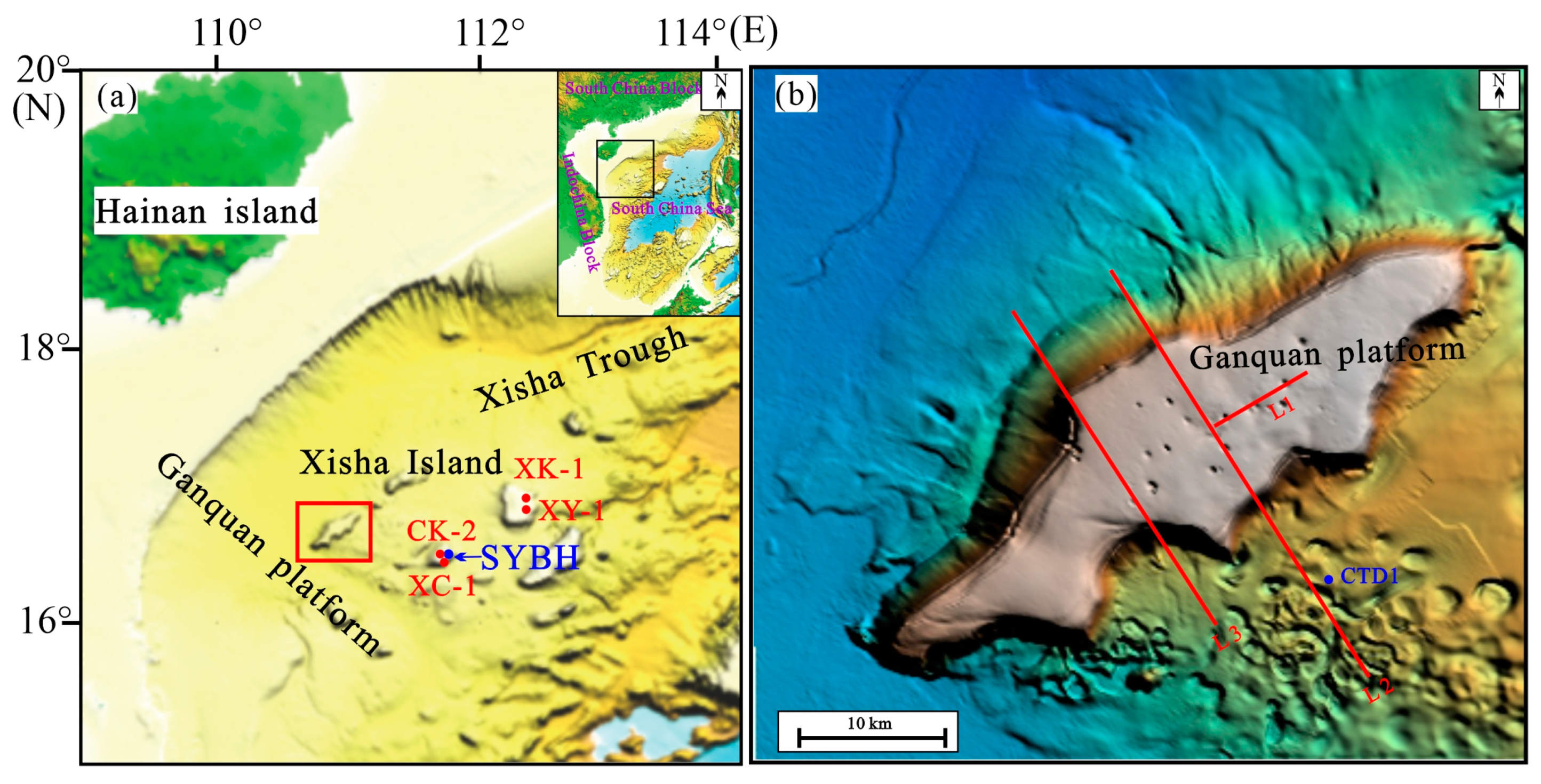
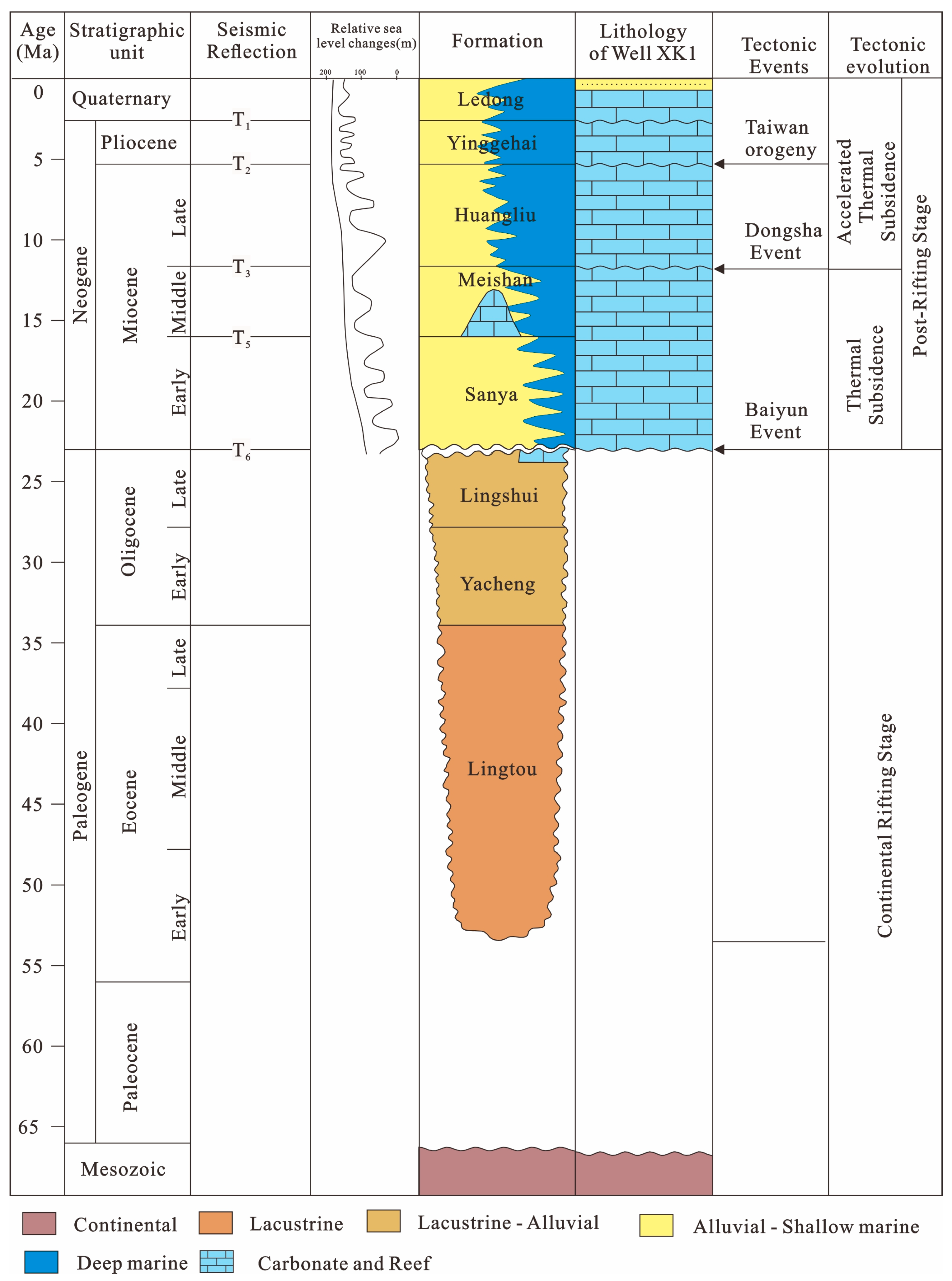

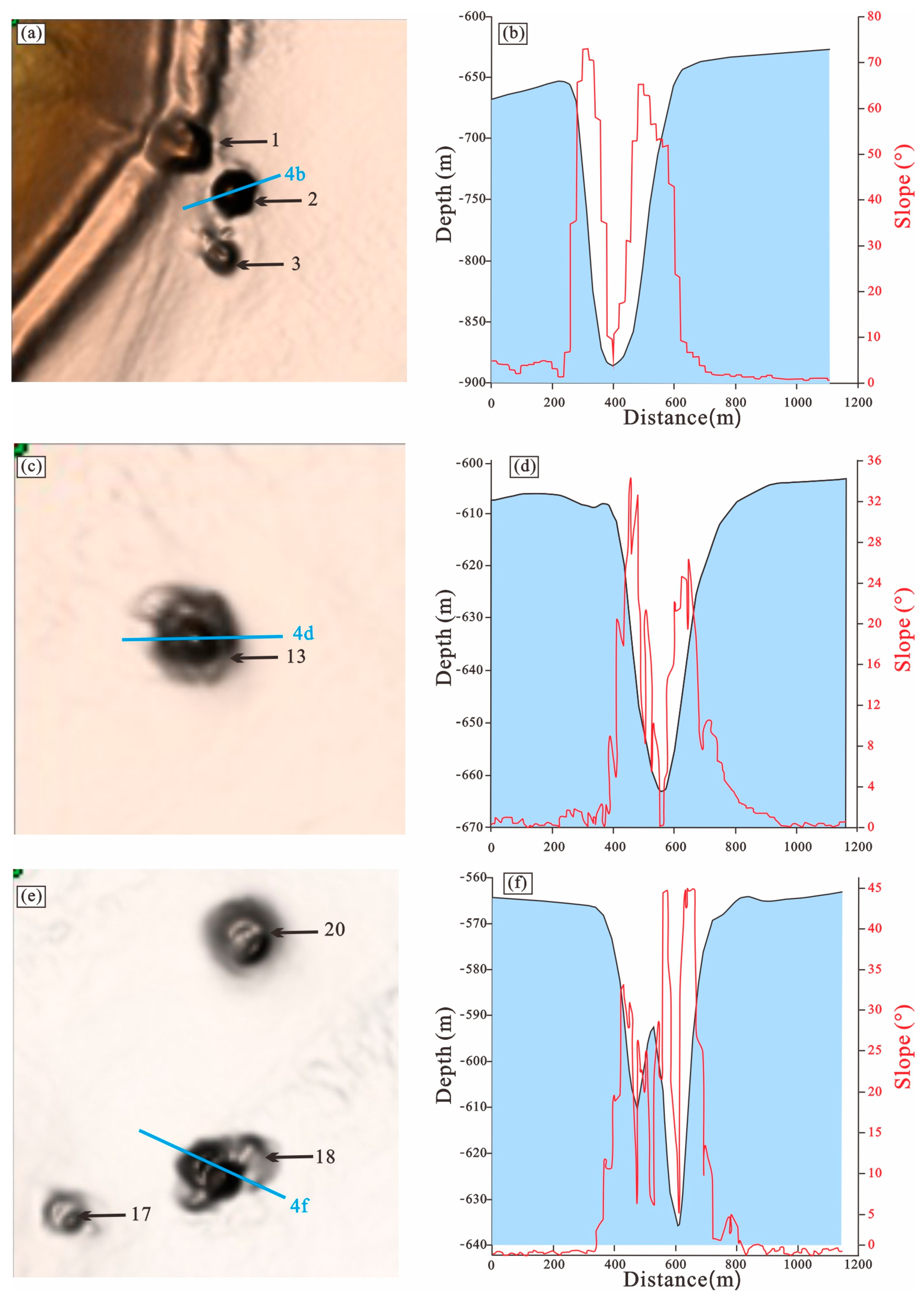
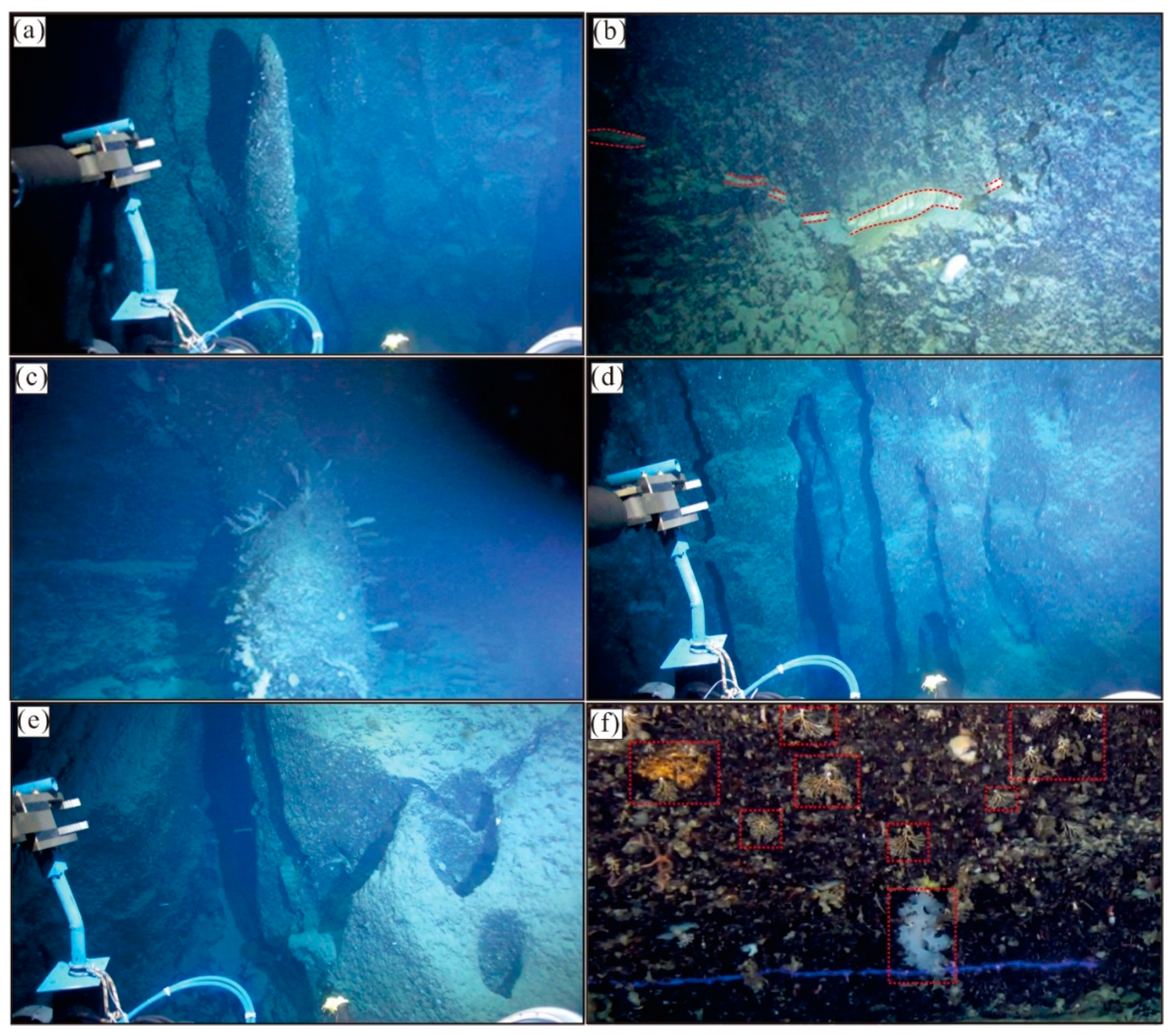
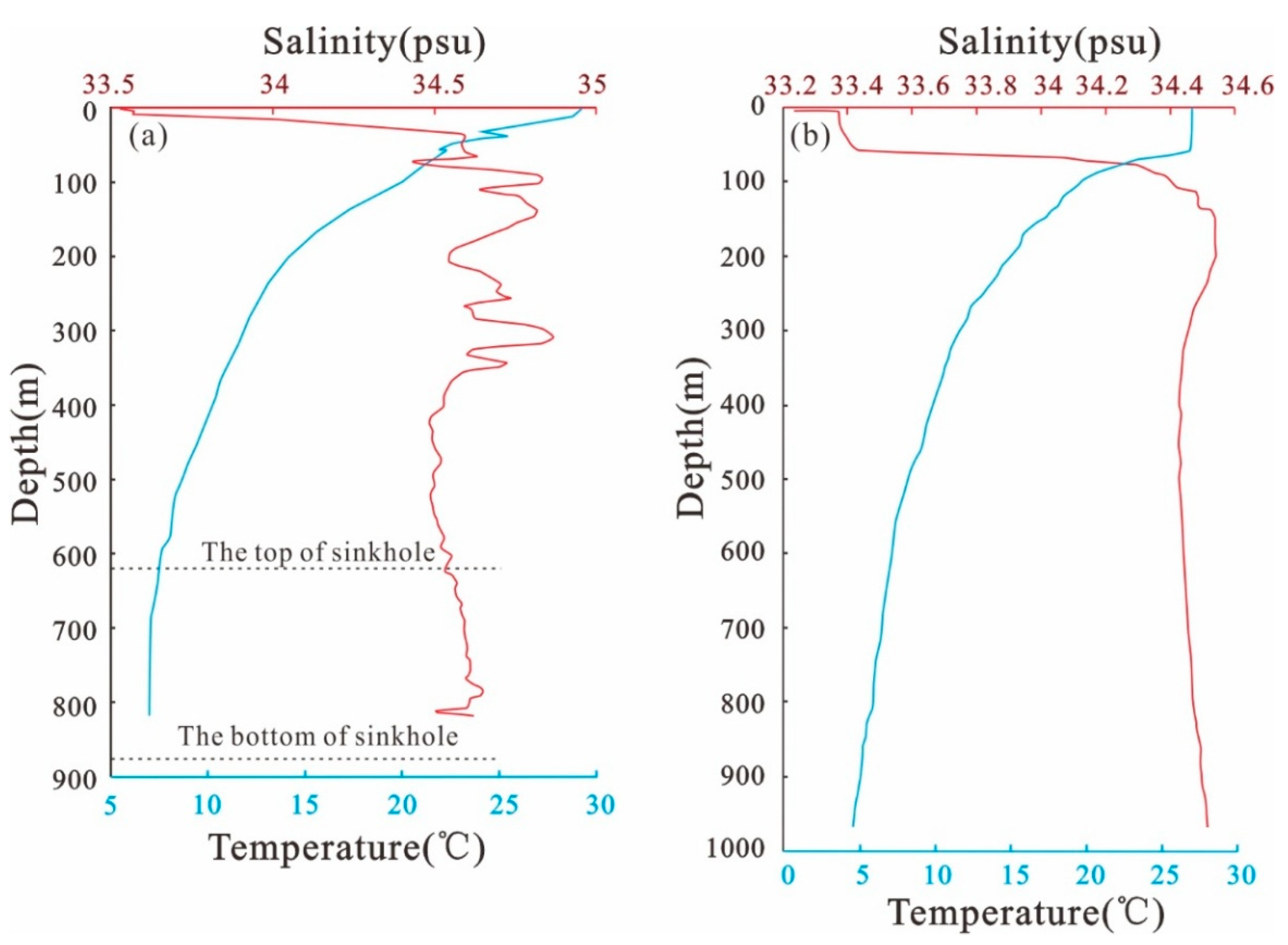


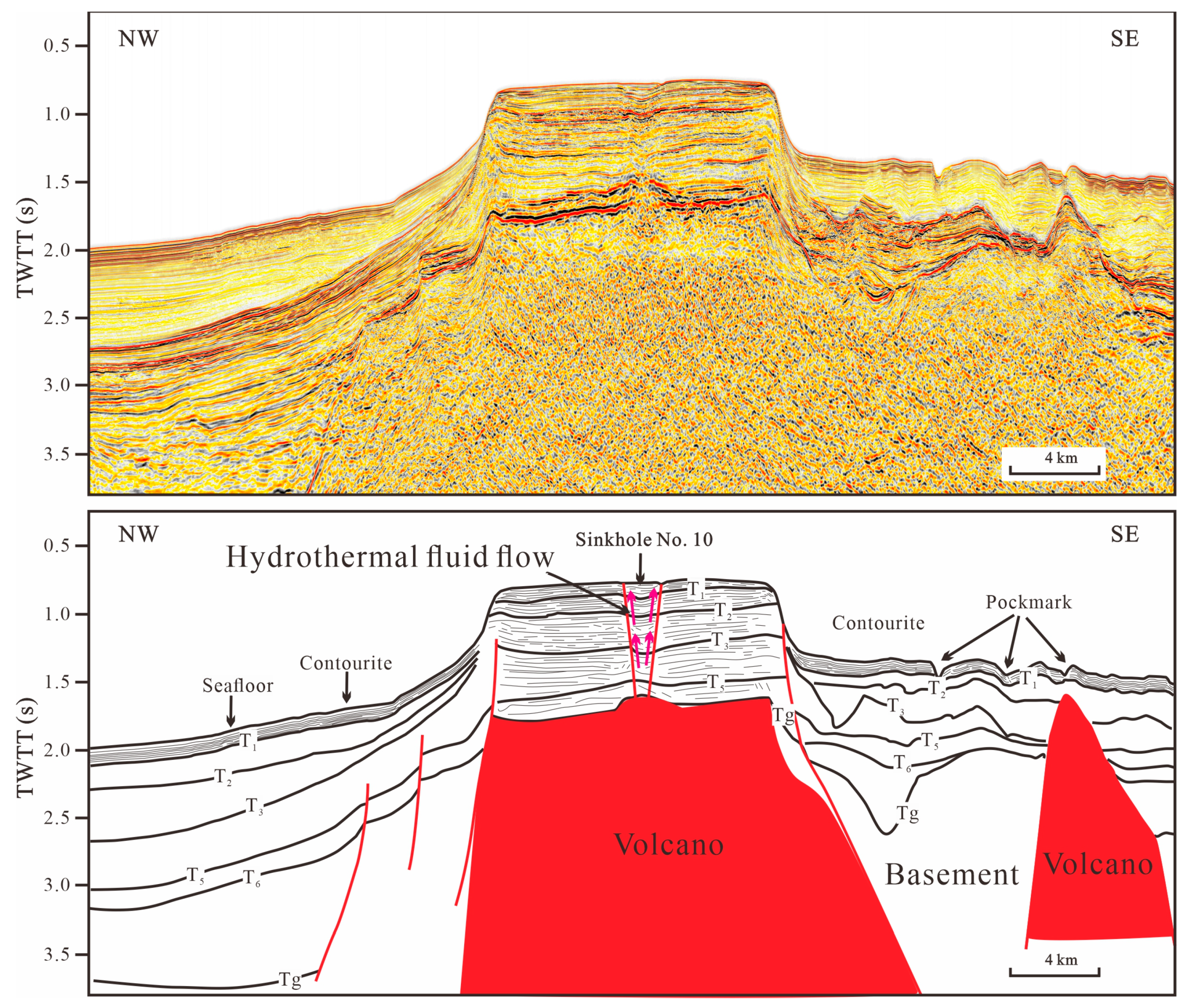
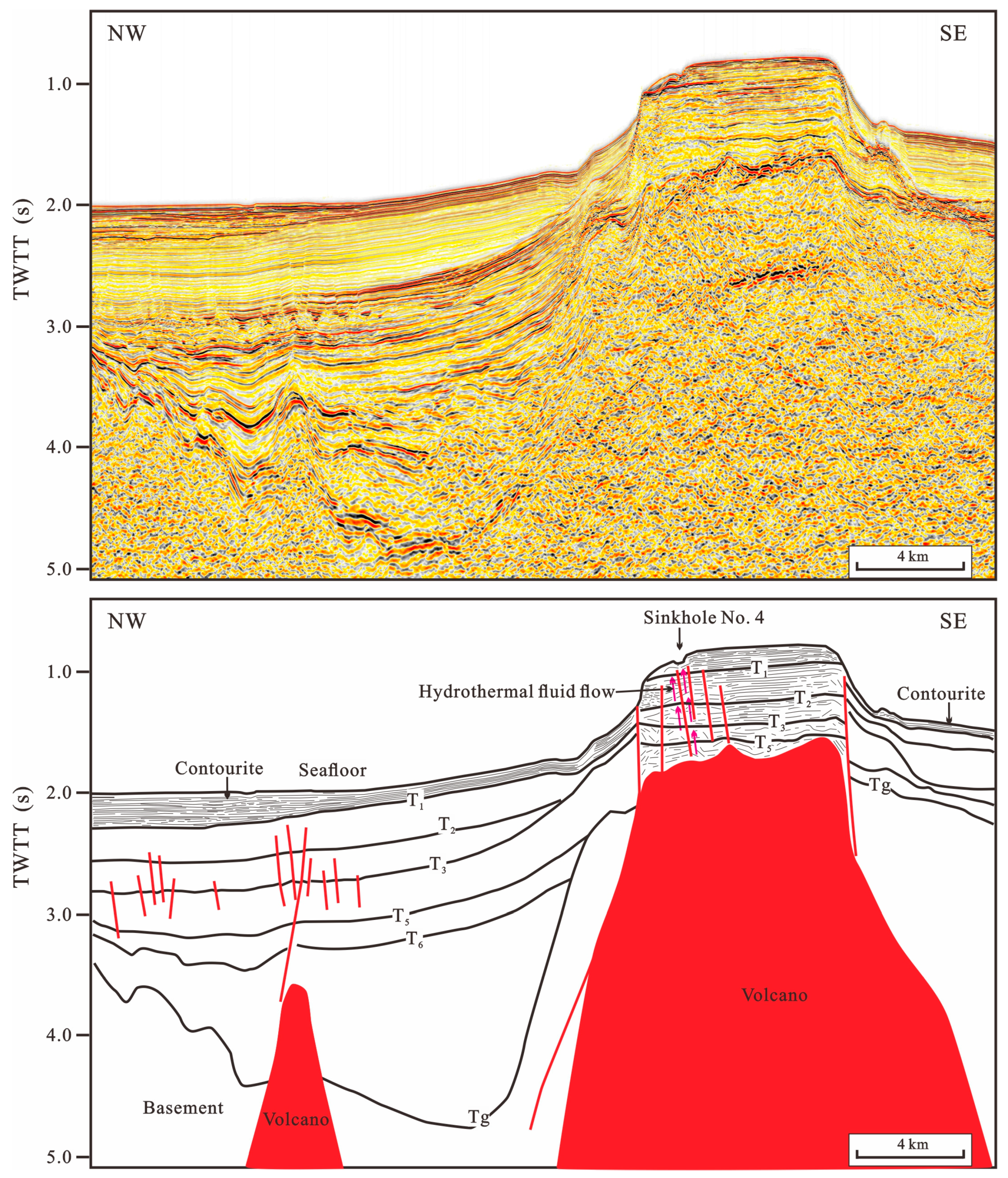
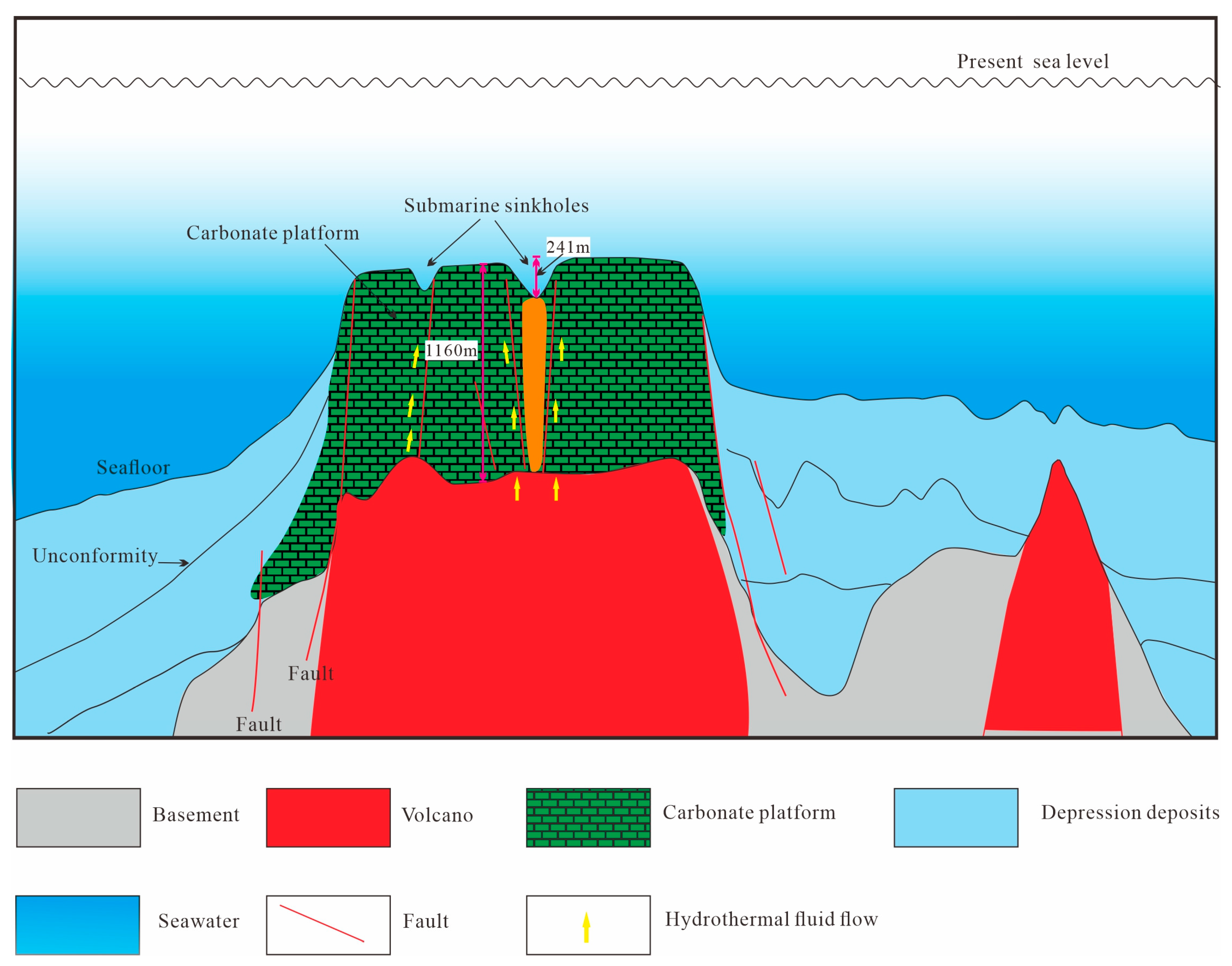
| No. | Water Depth (m) Top | Water Depth (m) Bottom | Depression Depth (m) | Length (m) | Length Orientation (°N) | Width (m) | Width Orientation (°N) | Average Diameter (m) |
|---|---|---|---|---|---|---|---|---|
| 1 | 724 | 778 | 54 | 596 | 132.93 | 545 | 44.85 | 572 |
| 2 | 642 | 883 | 241 | 483 | 175.42 | 369 | 83.53 | 449 |
| 3 | 647 | 693 | 46 | 354 | 89.86 | 301 | 138.11 | 330 |
| 4 | 591 | 655 | 64 | 453 | 197.05 | 371 | 121.25 | 441 |
| 5 | 593 | 683 | 90 | 667 | 66.25 | 504 | 43.33 | 566 |
| 6 | 598 | 624 | 26 | 489 | 176.66 | 392 | 83.85 | 465 |
| 7 | 597 | 651 | 54 | 474 | 62.06 | 388 | 150.21 | 435 |
| 8 | 586 | 672 | 86 | 582 | 57.79 | 380 | 147.85 | 459 |
| 9 | 586 | 631 | 45 | 261 | 135.26 | 237 | 42.56 | 252 |
| 10 | 573 | 662 | 89 | 602 | 60.57 | 427 | 156.26 | 501 |
| 11 | 599 | 620 | 21 | 359 | 47.93 | 258 | 142.67 | 320 |
| 12 | 613 | 691 | 78 | 360 | 133.16 | 328 | 47.21 | 339 |
| 13 | 609 | 678 | 69 | 503 | 141.85 | 414 | 54.14 | 468 |
| 14 | 580 | 700 | 120 | 546 | 63.64 | 456 | 124.96 | 487 |
| 15 | 582 | 607 | 25 | 506 | 172.35 | 351 | 80.06 | 416 |
| 16 | 580 | 599 | 19 | 610 | 91.75 | 462 | 183.47 | 519 |
| 17 | 571 | 593 | 22 | 408 | 132.09 | 329 | 43.75 | 333 |
| 18 | 571 | 650 | 79 | 696 | 56.55 | 418 | 153.16 | 550 |
| 19 | 561 | 575 | 14 | 295 | 140.07 | 287 | 48.81 | 293 |
| 20 | 571 | 627 | 56 | 542 | 157.53 | 499 | 66.64 | 502 |
| 21 | 595 | 676 | 81 | 626 | 154.65 | 571 | 62.48 | 574 |
| 22 | 550.5 | 556 | 5.5 | 152 | 71.22 | 113 | 176.2 | 172 |
| 23 | 596.5 | 605 | 8.5 | 214 | 90.68 | 211 | 19.23 | 213 |
| 24 | 559.2 | 563 | 3.8 | 285 | 30.79 | 234 | 131.34 | 267 |
| 25 | 1267.3 | 1282 | 14.7 | 351 | 40.68 | 308 | 98.26 | 321 |
| 26 | 1242.3 | 1254 | 11.7 | 363 | 86.9 | 327 | 178.94 | 338 |
| 27 | 821.2 | 863 | 41.8 | 263 | 179.63 | 240 | 89.01 | 264 |
| 28 | 776 | 798 | 22 | 218 | 59.98 | 195 | 150.9 | 207 |
| 29 | 583.5 | 586 | 2.5 | 305 | 61.5 | 213 | 168 | 268 |
| 30 | 589.8 | 596 | 6.2 | 229 | 31 | 208 | 121 | 214 |
| 31 | 593.1 | 596 | 2.9 | 150 | 167.1 | 142.8 | 88.1 | 148 |
| 32 | 600.7 | 604 | 3.3 | 201 | 118.8 | 157 | 45.6 | 180 |
| 33 | 704.1 | 709 | 4.9 | 151.4 | 204 | 137 | 117 | 143.6 |
| 34 | 794 | 799 | 5 | 177 | 104 | 97 | 191 | 145 |
| 35 | 1101 | 1115 | 14 | 109 | 227 | 78 | 149 | 95 |
| 36 | 1089 | 1115 | 26 | 83 | 229 | 38 | 130 | 66 |
| 37 | 1143 | 1159 | 16 | 88 | 231 | 57 | 145 | 76 |
Disclaimer/Publisher’s Note: The statements, opinions and data contained in all publications are solely those of the individual author(s) and contributor(s) and not of MDPI and/or the editor(s). MDPI and/or the editor(s) disclaim responsibility for any injury to people or property resulting from any ideas, methods, instructions or products referred to in the content. |
© 2023 by the authors. Licensee MDPI, Basel, Switzerland. This article is an open access article distributed under the terms and conditions of the Creative Commons Attribution (CC BY) license (https://creativecommons.org/licenses/by/4.0/).
Share and Cite
Du, W.; Yang, C.; Zhang, H.; Gao, J.; Wen, M.; Hu, X.; Xu, Z.; Nie, X.; Zhu, R. First Documentation of Large Submarine Sinkholes on the Ganquan Carbonate Platform in the Xisha Islands, South China Sea. J. Mar. Sci. Eng. 2023, 11, 2171. https://doi.org/10.3390/jmse11112171
Du W, Yang C, Zhang H, Gao J, Wen M, Hu X, Xu Z, Nie X, Zhu R. First Documentation of Large Submarine Sinkholes on the Ganquan Carbonate Platform in the Xisha Islands, South China Sea. Journal of Marine Science and Engineering. 2023; 11(11):2171. https://doi.org/10.3390/jmse11112171
Chicago/Turabian StyleDu, Wenbo, Chupeng Yang, Huodai Zhang, Jinwei Gao, Mingming Wen, Xiaosan Hu, Ziying Xu, Xin Nie, and Rongwei Zhu. 2023. "First Documentation of Large Submarine Sinkholes on the Ganquan Carbonate Platform in the Xisha Islands, South China Sea" Journal of Marine Science and Engineering 11, no. 11: 2171. https://doi.org/10.3390/jmse11112171
APA StyleDu, W., Yang, C., Zhang, H., Gao, J., Wen, M., Hu, X., Xu, Z., Nie, X., & Zhu, R. (2023). First Documentation of Large Submarine Sinkholes on the Ganquan Carbonate Platform in the Xisha Islands, South China Sea. Journal of Marine Science and Engineering, 11(11), 2171. https://doi.org/10.3390/jmse11112171







